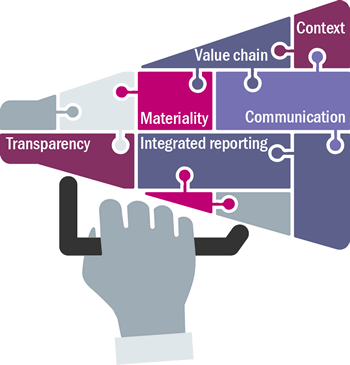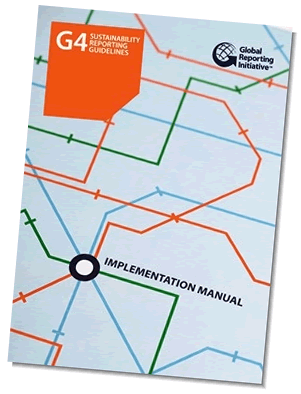“The future has already arrived. It’s just not evenly distributed yet.”
William Gibson
Rewarding the best of the best – the CRRA Awards
For the last three years Terrafiniti has had the distinct pleasure of supporting CorporateRegister.com’s annual CR Reporting Awards (CRRA 15), the unique global, sustainability reporting (non-financial reporting) accolades.
Our role has been to support shortlisting; reading and scoring all awards entries, which gives a fantastic snapshot of current practice in reporting across the world. This year (2014, for the 2015 Awards), the CRRA had a record number of entries, with around 100 organisations submitting reports.
As ever, the reports vary hugely. Coming from all corners of the world, some follow recognised best practice, others explore new approaches while some plough the same furrow they have done for years. Reports ranged from a svelte 30 to 40 pages to a dense 400!
Based upon the scoring, CorporateRegister.com shortlists the best reports in 9 different categories and opens voting to registered users of CorporateRegister.com (43,000 and rising at the time of writing). It is free to register on the site and the more people that get involved the better the Awards will be.
This post presents a high level overview of what we learned about the state of reporting from this somewhat exhausting exercise. It is a meander around the issues we feel are of wider interest rather than a scientific discourse. It does not seek to comprehensively cover every issue related to sustainability reporting at present.
It is also not seeking to represent the views of CorporateRegister.com or present a sober or statistical analysis of reporting.
We will not tell you which report we thought was best, worst, most serious or most fun. For that you need to take part in the CRRA voting process and decide for yourself!
A note on terms: In this piece, I tend to use the term ‘sustainability reporting’ to refer to any non-financial reporting (the communication of organisational social and environmental performance). Reports use a range of terms: ‘Integrated’, ‘Corporate Responsibility’, ‘Corporate Social Responsibility’, ‘Shared Value’, ‘Corporate Responsibility & Sustainability’, ‘Corporate Citizenship’ etc.
The Headlines
The following broad aspects, in our opinion, sum up the state of sustainability reporting at present:
• The overall standard of reporting seems to be rising – mostly because the poorest reports have closed the gap on the average; the improvement is typically seen at the bottom end. At the top end, already exceptional reporters have maintained quality.
• Tending towards the middle – there are probably fewer ‘awful’ reports but also fewer ‘utterly stand-out’ reports.
• Size isn’t everything – there are some very impressive short reports, though the giants can also be good.
• Increased global uniformity – there is a higher degree of consistency across territories, sectors and company sizes.
• GRI’s G4 is definitely making an impact – for the good.
• Context is still often largely absent – most reports ignore the fundamental sustainability context of business operations.
• The jury is still out on Integrated Reporting – both in terms of uptake (it’s not clear from our work whether the numbers are increasing) and in utility (an integrated report isn’t necessarily a better report).
• Assurance is not really moving forward – there is little apparent increase in the use of assurance or in the depth of engagements.
The Details…
Materiality – GRI’s G4 takes the concept into the mainstream
Materiality has been a concept experiencing a long and slow emergence into the mainstream of sustainability management practice. As far back as 2001, whilst I was at WWF-UK, we put materiality (although not using the term) in the form of ‘issues of strategic business concern’ at the heart of our publication providing guidance on aligning sustainability and business value, ‘To Whose Profit: Building a Business Case for Sustainability’. In 2003 Accountability published ‘Redefining Materiality’, the progenitor of today’s current approaches and we embedded it within WWF’s 2004 publication ‘To Whose Profit (ii): Evolution – Building Sustainable Corporate Strategy’.
Many leading companies have, over the intervening decade, used and adopted materiality within their sustainability management and reporting, but it seems that the emergence of the Global Reporting Initiative’s G4 Sustainability Reporting Guidelines (G4), with its (very welcome) materiality orientation has had a significant impact on the adoption of this concept.
The launch of G4 has meant that reports increasingly include references to materiality, disclose their approach to identifying material issues and list those issues – mostly through a materiality matrix. We believe that this has had a significant impact in terms of raising the quality of reporting.
However – a report which follows G4 is not always a better one! There are still organisations which use G4 but tend towards opaqueness regarding the processes they use to identify and prioritise issues.
In addition, a report can have a materiality identification approach and matrix but then dive straight into a series of content sections without maintaining a materiality narrative or cross-referencing issues. There are some honourable exceptions to these phenomena; some organisations not only explore the relationships between their material issues, but also consistently cross-reference them throughout the content of their reports.
With GRI cross referencing, the devil is in the detail. Just as with G3.1, some reports will report full compliance to a section when that is not justified in the content, or display an incomplete understanding (or interpretation) of what GRI is asking for.
Context (the big picture)
Context is at the heart of truly strategic sustainability reporting and management . Over the years context has been conspicuous by its absence in the majority of reporting in practice. Set against this non-trend, there has been growing clarity on the global mega-trends that will increasingly shape the operating context for the business – providing new and evolving sources of threat, opportunity, limits and possibilities. Sustainability management and reporting which ignores this context is neither strategic nor very sustainable.
Despite this, most reports ignore context. Some include information on big picture megatrends but do very little with them, the majority focus instead upon incremental reductions in impact (concentrating on being ‘less bad’ rather than understanding and communicating whether their activities and plans are, in any categorical way, actually sustainable).
Some of the bigger (mostly mature) reporters however do seem to ‘get’ context. Those with a clear and direct dependency upon the productivity of natural systems are starting to locate their performance within the context of the planet’s limits, though there remains a huge distance to travel on this journey.
Organisations with water hungry processes and products tend to be advanced in the use of strategic tools which contextualise their practice in terms of absolute availability. However, all too often, companies are still limiting their ambition to ‘do less damage than last time’.
At the top level there is a generally poor coverage of big picture global drivers and how they will shape strategy and business opportunities in the coming years. At a more specific level, few companies are doing more than paying lip service to a statement (if at all) of the main trends – resource and energy squeezes, the water/food nexus and demographic changes.
Integration
Each year we see a number of integrated reports. Long touted as the ultimate destiny of non-financial reporting and predicted to join financial information in a consolidated format, it is still unclear if their use is on the increase.
A number of such reports use the International Integrated Reporting Council (IIRC) Framework or are part of the IIRC pilot – and many use a multi-capitals approach (categorising ambition and performance in the context of different capitals: financial, manufactured, human, intellectual, natural and social). However, there seems to be a poor understanding of what a capitals approach means and some companies treat it incredibly shallowly. For example, a number of companies reporting against natural capital did so only in terms of efforts to minimise direct operational impacts – entirely ignoring the impacts of core business on natural capital. It is especially problematic when extractives or finance companies take this approach.
The continued emergence of geographical regions
Recent years have seen an increase in the quantity and quality of reporting from around the world. Particularly notable are reports coming from South Korea, Brazil and Canada in terms of quality, ambition and approach.
Of these three areas, South Korean reports in particular are improving in quality and scope. Their approaches are more consistent than you tend to find from a single geography and they often use ISO 26000. This is very likely driven by clear signals from the Korean government and is also supported by the work of the Korean Standards Association (KSA) – which has developed an assurance-like assessment procedure using ISO26000.
Sustainability reporting strategy, targets and performance – could do better!
Many reports still fail to report or explain strategy well and/or to link it convincingly to wider report content. Even worse perhaps, some companies will refer to their strategies a number of times but without actually describing what it is! For example, “Our sustainability strategy empowers us to create a positive impact etc. etc.” but not “Our strategy is XXX”.
There are still far too many unjustifiable examples of non-contextualised data (e.g. “we trained 170 people last year”) and too much activity-based ambition: “Next year we will engage more”, or: “We will expand on site generation of renewable energy, since 2008 we have generated 20 GWh”. The continuing existence of such disclosure serves to reinforce the idea that sustainability performance is not serious, not meaningful and raises the dreaded spectre of greenwash.
In performance reporting there is a perceptible, though probably not statistically supportable, growth of a ‘We said, We have, We will’ format for performance disclosure. We like that!
Assurance – saying less and less every year
The quality of assurance seems to have declined in recent years, it is less informative and more about risk mitigation/avoidance than adding value. This is a challenge, especially as it is only a minority of reports which include assurance in the first place. This decline seems to be due to the ambition of companies commissioning assurance engagements, perhaps indicating risk aversion on the part of reporters.
Assurance statements are frequently ‘limited’, and often based on ISAE3000 or equivalent, do not include (or publish) recommendations and are generally confined to a double-negative bound conclusion e.g. “We didn’t find anything that lead us to believe that the contents of the report that we were asked to assure weren’t accurate within the context of how they were stated”.
There is the odd brighter spot where a company has engaged ‘reasonable’ assurance to ISAE 3000 or even used AA1000AS as the methodology for the assurance engagement. These assurance engagements tend to produce statements with meaningful findings, observations and recommendations for the further development of sustainability management and reporting. Such statements are a breath of fresh air in the context of the stale pseudo accountancy-speak of most report assurance.
While there is some debate about the theoretical and realised utility of obtaining independent, third party assurance for sustainability reports, assurance should perhaps be seen as a required part of any good report. For much more discussion on assurance, whether it is required and what to look for, see our brief piece on the issue.
Conclusions?
As noted in the headlines at the start, there are clear trends in sustainability reporting emerging from the reports we reviewed as entries to the CRRA 15. This sample is of course not necessarily representative of sustainability reporting as a whole, but it is representative of those reports considered by someone (probably the organisation reporting) as being good examples with at least a chance of winning an award. In addition, it undoubtedly contains some of the world’s best reports.
In my opinion the sample tells us the following, that:
• Sustainability reporting is getting more uniform, more consistent and uses more common elements – in short it is becoming more standardised.
• In a small number of cases, reporting is locating itself in the context of the global challenges facing the planet and its inhabitants and starting to indicate how performance rates on a scale of absolute sustainability rather than relative responsibility.
• Reporting is developing fast in some parts of the world and more consistently and impressively than in others.
• Integrated Reporting still has much to prove in theory and in practice.
• Performance disclosure is patchy but improvements by some organisations do tell us something meaningful about work to reduce environmental and social impacts.
• Assurance seems to be losing its way – before it ever really found it.
Reporting has traveled far over the past two decades. It is increasingly about core business, strategic context and strategic integration. Yet it still has further to go and requires many changes in the outside world in order for sustainability disclosure to be understood as equivalent or even greater in importance than financial information. The entries for the CRRA 15 represent a snapshot of the progress so far in this journey, we look forward with interest to where reporting will take us in the coming years.
This post was also published in two parts by 2Degrees on 2/12/14, by Sustainable Brands on 11/12/2014 and TSSS (Toronto Sustainability Speaker Series) on 31/01/15.









Leave a Reply